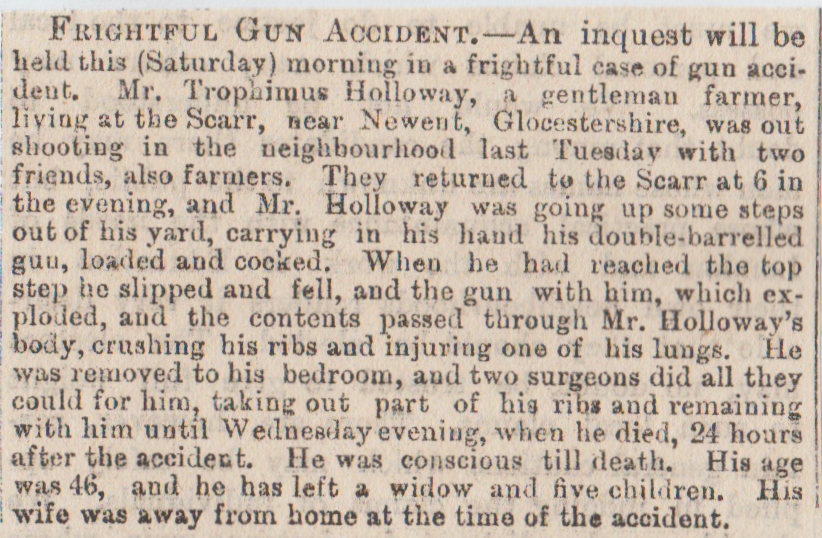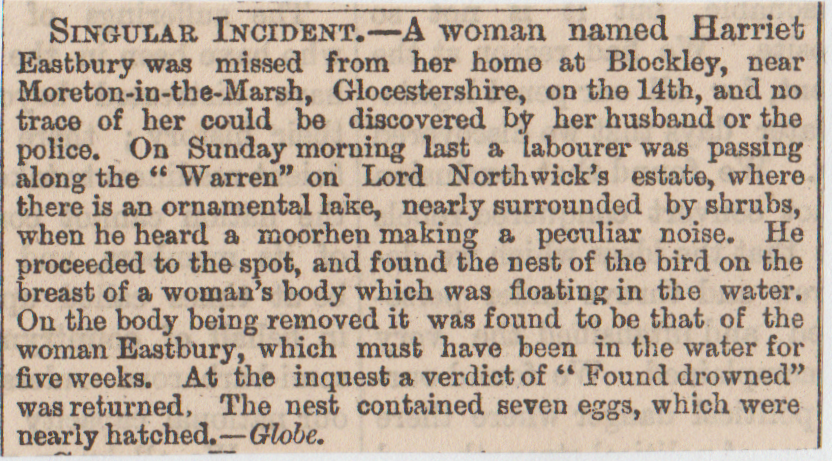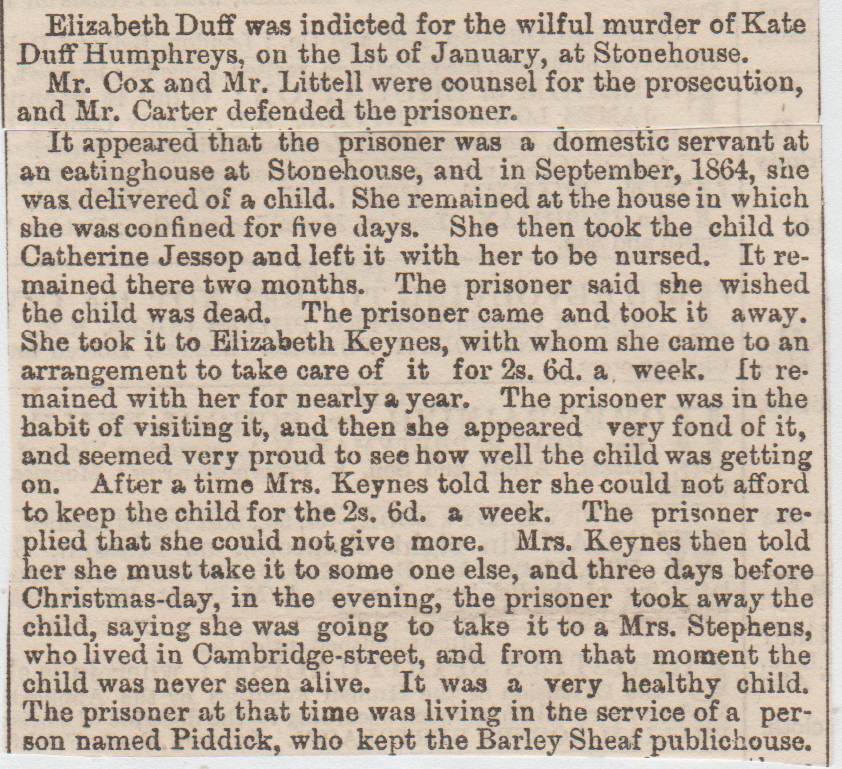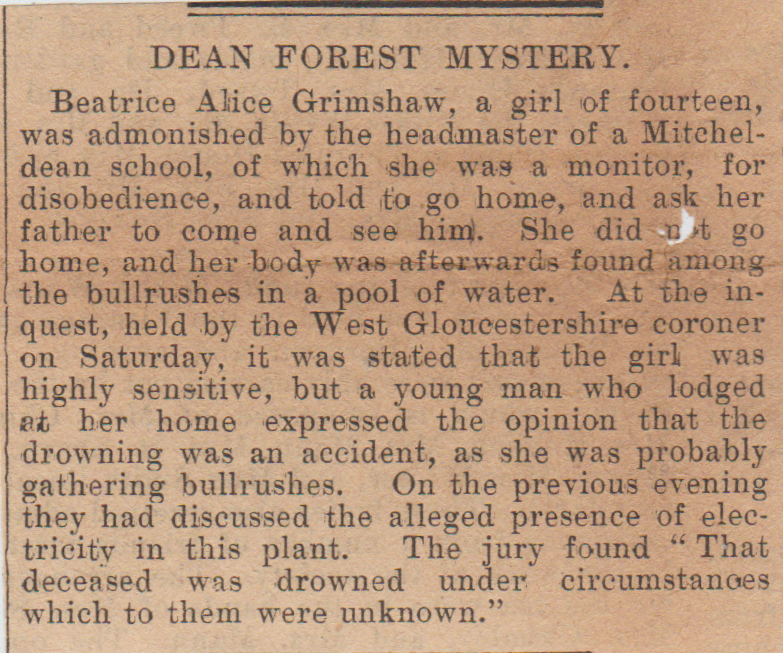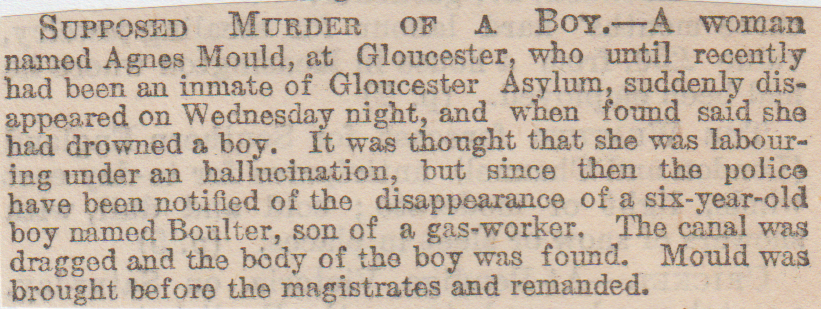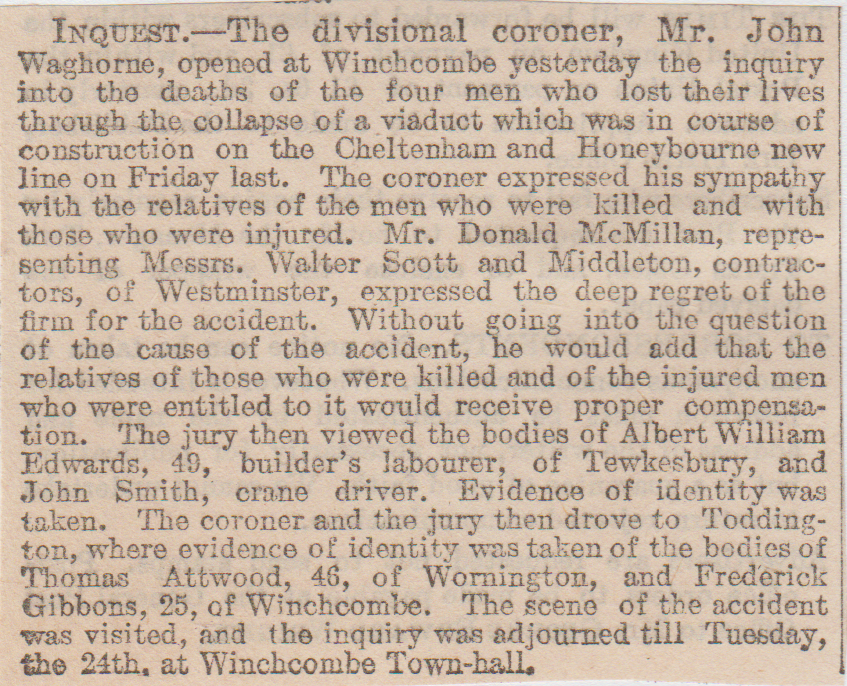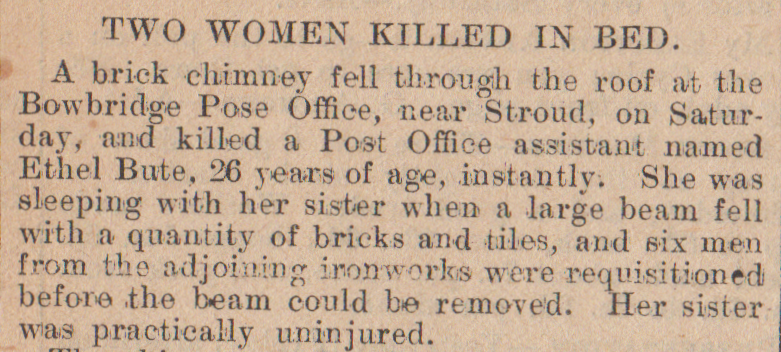1/ Cheltenham Suicide, September 1851
A lady killed herself in a fit of insanity and had been recovering from bronchitis. Despite a close eye being kept on her she went upstairs and threw herself from a window (about fifty feet). The head was nearly severed from the body. The lady had a premonition that she’d die on the 27th August, because her husband Colonel Crowder had died after an illness on this date.
(Holy Trinity Church Monumental Inscriptions-Portland St, Cheltenham)
Eliza Pulleyn Crowder August 27th, 1851 Colonel John Crowder K.H. August 27th, 1838
2/ Gloucester (Dead Children in Garden) June 1883 (See No.27)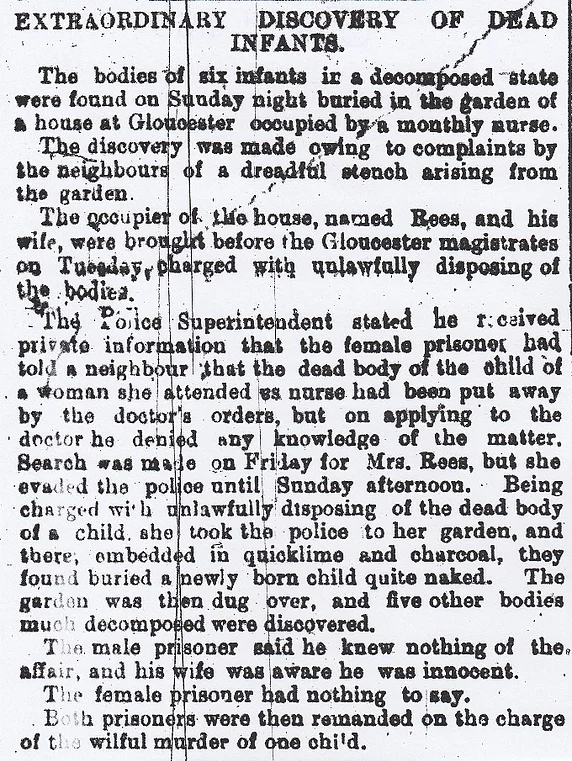
3/ Pittville Gardens, Cheltenham, (Lake Suicide) June 1877
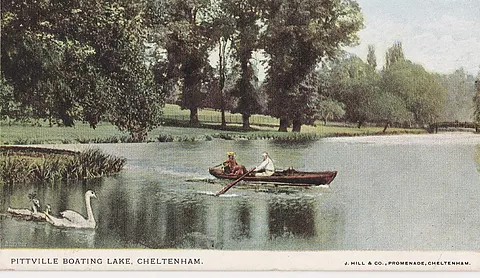
The 17-year-old servant girl, Emma Potter’s body was found in the lake at Pittville Gardens by a couple of young lads. Emma was a servant to Mr Burns, a music master, from Regent Street, Cheltenham. She got the job by a forged character reference and her employer found out and told her to leave immediately. That was the last anyone saw of her, next time they were fishing her out the lake. It was thought to be suicide but how she got there is anyone’s guess.
4/ Thornbury Murder, May 1891
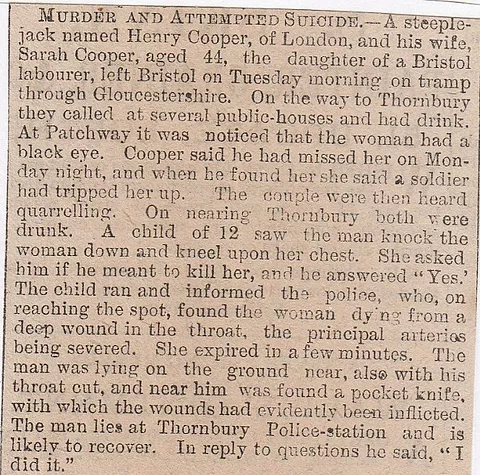
5/ Churchdown Station Death, March 1892

6/ Swineford Mill Death, March 1857
The copper-mill at Swineford saw a hideous accident take place one morning when a worker was stood next to the rollers when his smock-frock got entangled in the works. He was pulled twice round the roller, squashing and flattening his head, and the body also mangled up. When they managed to extricate him from the machinery, he was totally lifeless. (Name?)
7/ Gloucester Asylum, December 1864 (Lunatic Suicide on Railway)
Joseph Davies was an inmate of the County Asylum, and he managed to both attack and then escape from the staff nurses at the Asylum. After running off he placed his head on the tracks and let the railway run over him. Davies had been here for ten months or so and he was in the airing ground with a few others, when under the watchful eyes of the keepers named Wilks and Constable. He suddenly went into a frantic mania then started to attack other patients and staff. Davies kicked Wilks in the groin and then ran off like Usain Bolt across the fields where he reached the railway line and then lay his head down and allowed the train to sever it from his body.
8/ Stroud, Gloucestershire, December 1904
About a mile out of town lay Wickeridge Farm, run by Robert Lamb. The 30-year-old had been there for about three years having got injured in the South African conflict where he was with the Imperial Yeomanry. He got injured in the leg which made him limp slightly. One day he went out with his gun and told his wife he’d be back later. He didn’t come back, so his wife and others went looking for him. Lamb was discovered with his gun by his side in some bushes laid on his back with the muzzle pushed into his body. It is thought it is an accident rather than suicide, as next to where he was found is a stile and the gun could have accidentally fired while he was climbing over it.
9/ Cheltenham Suicide, February 1895
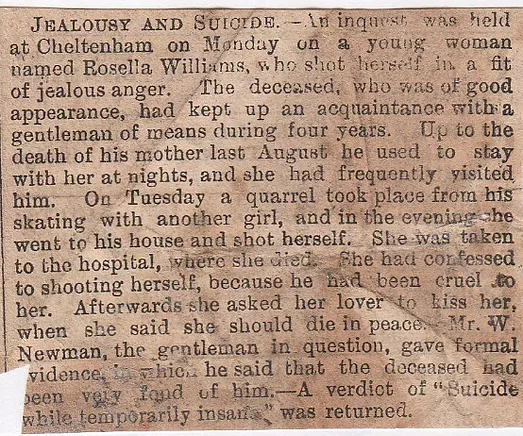
10/ Gloucester Lunatic Asylum Suicides, October 1846
Two inmates, Elizabeth Gwythers, aged forty-five and William Drew aged seventy, both committed suicide at Gloucester Lunatic Asylum, by hanging themselves.
11/ Newland Murder/Suicide, October 1840
Philip Willis attacked his wife and daughter in a bid to kill them, then he cut his throat. They were all together having tea when the daughter went out to get kindling for the fire. While doing this her father crept up behind and smacked her on the head with a hatchet. She began to scream for help so the mother came out and he then struck her three times. She managed to fend him off but sustained a black eye, bruises and a cut on her shoulder. Nearby some men from the coal pits came to her aid and Willis ran off to the orchard and slit his own throat. The daughter told the mother that she was all right and they went to a neighbours house. The daughter was put in bed and she kept asking why her father didn’t want to see her, obviously still not knowing it was him that committed the heinous crime and within the hour she slipped out of consciousness and died. Willis had previously been to Whitchurch Asylum for two months to try and cure him, but he was clearly insane.
12/ Cheltenham Station Death, April 1899

13/ Minsterworth near Gloucester, August 1875
Four men were fishing on the Severn near Minsterworth, about four miles from Gloucester when one of them spotted a man’s hand in the sand. They tied a rope around the wrist so that the body wouldn’t be washed away again, and then at low tide, it was dug up. It is supposed to be the body of a man recently swept away by the floods. (Who was he?)
14/ Clearwell Court Suicide, May 1866
28-year-old Ann Williams, a nursemaid, cut her throat with a razor between nine and ten o’clock. Williams had worked for the Countess of Dunraven for eight years. The doctor had visited her recently and treated her for influenza, but he’d also heard some rumours being spread about her which were entirely unfounded. This is the jury’s verdict:- “The jury find that deceased, Ann Williams, destroyed herself, but we have no direct evidence as to her state of mind at the time, but the fact of insanity having shown itself in her family, and her being in a low and weak state of health, lead them to believe that she was of unsound mind when she committed the deed”. The Countess of Dunraven left Clearwell Court after the incident. (Is Clearwell Court still there?)
15/ Sharpness Murder, February 1885

16/ Hand in Heart, Cheltenham, May 1845
Edward Bull, aged twelve years, the son of the landlord of the Hand in Heart beer-house, Mount Pleasant, Cheltenham, asked his Mum if he could go and see the famous magician, Bernardo Eagle. She told him he couldn’t and sent him up to bed. Later on, she went to check on him and found the youngster hanging to his bedpost with his handkerchief tied around his neck.
17/ Tidenham (Teenage Suicide) October 1835
The 15-year-old daughter of Abraham Miller, landlord of the Traveller’s Inn at Tidenham, hanged herself in the stable. She was cut down straight away and the surgeon was sent for, and with great care and treatment, she recovered. The only reason she tried to commit suicide was that her Mum told her off.
18/ Star Inn Suicide, Gloucester, June 1846
George Beard, the landlord of the Star Inn, Gloucester, took his own life under the following circumstances. On Friday night he went to a Druid’s dinner and got home a little worse for wear. His wife had strong words with him so he walked out, and went back to the Inn where they had the dinner. They put him up for the night so he could sleep it off but when they entered his room the next morning he’d hung himself with his handkerchief (How big were Victorian handkerchiefs?) He left a wife and six children and the verdict was down to “Temporary Insanity”.
19/ Hatherley Wood Suicide, June 1869
A young lad was in Hatherley Wood when he saw a bloke sitting on a tree stump, or so he thought. When he got closer the man was actually hanging from a tree branch, so he went to get help and he was cut down. The deceased man George Yettle aged65, a labourer, who worked for Mr Arkell, of Baddington House near Cheltenham. He was from Marlborough and had been in this area for five years or so. One thing you could say about Yettle, was that he liked a drink, and had been on a two-week pub crawl and then got a bit morose and gone to the woods and hung himself.
20/ Whitminster Burglary, February 1885

21/ Hempstead near Gloucester, August 1857
William Jones aged seventeen was an apprentice to Edwin Jeffs, a hairdresser of Eastgate Street for a couple of years, and lived with his boss too. He told him one day that he was seeing a young girl named Dean, so Jeffs was pleased for him and wished him well. One Sunday he was off to chapel when he saw Mrs Dean, the mother of his supposed girlfriend and gave her a letter. She took it and went inside the chapel then when service was finished she took out the letter and read it. It said:
“Annie, thou who I once could love without being rebuked. My heart is so full I can say no more; only do raise an alarm as soon as you have read this letter. May God the Father, God the Son, and God the Holy Ghost have mercy on my soul, from your unfortunate, wicked yet dear and ever fond and affectionate lover, Willie”. Mrs Dean had read the letter meant for her daughter, but just as well she did. Mrs Dean got in contact with Edwin Jeffs but nothing more was heard of him until they fished his body out of the Severn at Hempstead. The body was decomposed and the jury’s verdict was the usual one. “Drowned himself while temporarily insane”.
22/ Bishop’s Cleeve near Cheltenham June 1830
A lady named Da Costa, who has lived in the village for many years, calmly crossed the road with a gun in her hands then placed it to her chest and fired. She had been subject to fits of depression and always had the belief that something bad was going to happen to her. She thought she saw men hiding in bushes ready to shoot her. Death was instantaneous and her family in Spain will be notified. (Sounds like schizophrenia, where you think people are after you.)
23/ Lasborough Park Death, November 1833
Mrs Caroline Walrond, the widow of the late Joseph Lyons Walrond, was sat in the library at Lasborough Park after a sumptuous dinner when her cap set fire from the candle. Then trying to put the flame out she fanned them and then her dress was a ball of flames. When the fire was put out her body was a charred mess and consequently, she died the next day.
24/ Dursley, July 1895
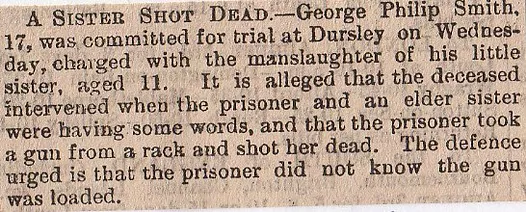
25/ Wood Stanway Child Murder, October 1894
The dead body of a child was found in a garden at Wood Stanway on the estate of Lord Sudeley. It was a foot below the surface and now the niece of the lady who rent’s the property has been arrested by police for concealment of birth. The cadaver is that of a fully developed child whose head was discoloured, which suggests foul play.
26/ Cheltenham Suicide, December 1854
An elderly gentleman killed himself at Cheltenham so that his remains could be placed in the same churchyard as his dead wife’s. It is due to be closed later this month so he presumed time was of the essence. (Name?)
27/ Gloucester, June 1883 (Buried Children. See No.2)
The story sounds familiar! Dead bodies in a garden at a house in Gloucester (Fred and Rose West). This one was in 1883, and the corpses of several babies were discovered. The person who lived at the property was a man named Rees, who along with his wife were charged with disposing of the youngsters. When police went to the house, for further searches to be made, she had disappeared then she was captured. They were charged with unlawfully disposing of a child; she took them to the garden and there they found a new-born baby boy covered in quicklime. Police broadened the search and dug up five other bodies. The other bodies were unknown to the husband but they were both remanded on the charge of “Wilful Murder” of a child. As soon as the handcuffs went on Mrs Rees she said “Oh dear, what shall I do?; what will be the end of it? what will become of me?”.
What had happened was that she’d been to various pregnancies as a midwife, and when the children were stillborn or premature when they told the mother the child was dead, Mrs Rees said she would have it buried and was given money to pay for its burial. She kept the money and just dumped them in her back garden. They were charged with “Wilful Murder” of the one child, and an open verdict for the other dead children.
28/ Kemerton near Tewkesbury, December 1886 (Suicide)
The death of Samuel Adams, the head gardener at Kemerton Court. Firstly, he dug a grave in an outhouse and piled a load of wood in it, poured petrol over it, then climbed in and lay down and torched it all. It was a sort of DIY funeral pyre, but when they found it there was nothing left of him except a few bones and teeth. Apparently, he thought that God had ordered him to destroy himself, as he’d been suffering from a religious mania.
29/ Prestbury Suicide, March 1899

30/ Gloucester Cathedral Death, May 1859
Several workmen have been employed at Gloucester Cathedral repairing the great window and preparing it for some stained glass to be fitted for the Bishop Monk memorial. One of these workmen, Samuel Matthews, was on the scaffolding when it collapsed and he fell and was dead on the spot where he landed.
31/ Slimbridge near Dursley, January 1841
Elizabeth Burley was a 20-year-old daughter of a blacksmith, from Slimbridge. One morning she got up and made breakfast, then left them to eat it. Moments later the two brothers thought they heard a door slam shut and since their sister was not there they went up to her room. Inside was the girl slouched on the floor with her face blown away. She had sat on a chest, put the gun against the wall, and fired by placing a red-hot ramrod to the touch-hole. Brains and blood everywhere but it seems this wasn’t her first go at suicide, as two weeks ago she tried to cut her throat. The verdict was”Derangement of Mind”.
32/ Mitcheldean, October 1839
Aaron Nicholls, a 29-year-old miner, had been seeing the servant of Rev.Henry Birkin of Forest Parsonage House, and her name was Adeline Jenkins. He had a penchant for a drink so she dumped him, but he turned up at the parsonage wanting to see her. He threatened to kill her if she went out with another man and then he’d kill himself. The Reverend escorted him out and went to do a lecture. Next morning the Reverend opened the curtains and there meeting his gaze was Nicholls swinging from a tree in the parsonage garden. He’d hung himself several hours ago. The verdict was one of temporary derangement.
33/ Gloucester, August 1869 (Suicide)
Lucy Smart was the girlfriend of James Davis, a local farmer, and a couple of months ago an effigy of one of them was burned in the village. Lucy left the area but Davis continued to see her and sent her cash to get by. A week or so since she came back to the village, so Davis went to see her, but she told him she’d either drown herself or go away for good. At 10 a.m. one day she gulped a load of blue vitriol down then rushed over to Davis’s house, while foaming at the mouth. Smart died in great agony that same evening and the verdict was “Felo de Se” from the inquest.
34/ Chipping Campden, May 1849
Mr Potter of Charringworth employed 55-year-old John Brown as a carter. One evening he was asked by Potter if he would stay up and watch a mare give birth to a foal, but he didn’t do as told and the two horses died. The mare was the favourite horse of his master, so when he saw him he gave him a proper mouthful. Brown was upset by his master’s outburst and when he was told that he couldn’t stay and watch the second mare who was also due to give birth he really went downhill. When they entered the stable they found Brown suspended to a beam in the cart shed, dead as a dodo.
35/ Gloucester Train Murder, May 1899
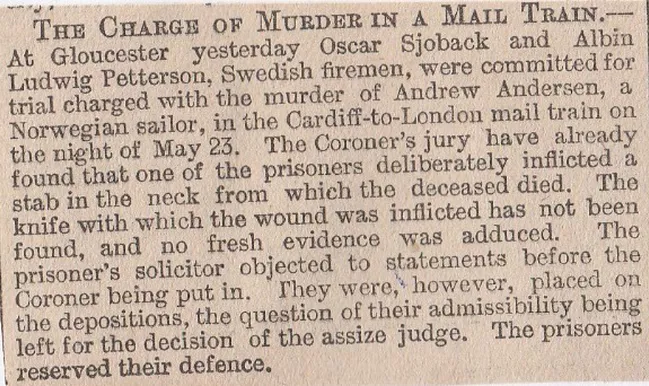
36/ Bullo Pill Drownings, October 1898
It says in the original paper, Bone Pill, but can’t find that, so presume it’s Bullo Pill. Anyway, two teenage boys named Clutterbuck and Jones drowned at Bullo Pill in the River Severn. They were in a group of eight lads when the water bailiff warned them that there was deep water nearby, and so they all took the advice and left the river and got dressed. Later on, their mates, who thought they’d got out as well went back to check on them, along with a search party. Unfortunately, they were spotted face down in the water and were stuck in the mud.
37/ Gloucester, November 1852 (Tragic Saw-Mill Accident)
Francis Ayres was a sawyer, who worked for Mr Essie at his saw-mill, on the banks of the Gloucester and Berkeley Ship Canal. Massive saws cut through Baltic timber, to be used as railway sleepers and it was all steam powered. There are numerous saws that do the work here and they cut through the wood at twelve feet per minute. Ayres used to feed the timber into the machinery but he was doing his usual job when he tripped over and fell under one of the saws while it was in motion. It virtually sliced him in two tearing through his rib-cage like a hot knife through butter. His internal organs were damaged and it cut him up to his spinal column. It is believed an accumulation of wood was in the mill so it was it was quite cluttered in there and this is why he tripped up. It was ruled “Accidental Death” and the owners were told to tidy up the mill. No heavy fines, no manslaughter charges, nothing at all, they got away scot free.
38/ Cirencester, April 1884 (Suicide at Solicitors)
Dr William Wells of Ravenhurst Lodge, near Cricklade, committed suicide during an interview with his solicitors, Messrs Mullings, Ellett and Co.of Cirencester. He went to Cirencester to get some business sorted out at the solicitors and at around 1 o’clock, at the offices, he had a private meeting with Mr Ellett, one of the firms’ partners. When a solicitor takes you into another room for a private chat this means bad news, and it must have been because after he’d finished the talk he took out a bottle of poison and gulped it down. They tried to resuscitate him but all too late. The bottle contained cyanide of potassium and Wells was in his seventies, so he stood little chance of survival and indeed it was down to his financial situation that he did it.
39/ Oakle Street Station Suicide, February 1880
This is a sad tale of how Frederick Sherwood, a young lad, was accused by his mother of nicking five shillings out of her purse and now she had nothing for the food shopping. The older brother asked him to give the money back and he’d make up the difference if he’d taken any. Sherwood denied any knowledge of the money vanishing and in a temper, he went to the pub to drown his sorrows. While in there he mentioned his predicament to a few bar-flies and told them that he would go to Oakle Street Station and lay on the rails and wait for a train to run over him. This was taken with a pinch of salt but the next day his body was found on the railway tracks. “Felo De Se” was the verdict.
40/ Sandywell Lunatic Asylum/Cheltenham, April 1850
Dr Bell, who was a physician, and who had a long stay at Sandywell Lunatic Asylum, was well enough to go home to visit his wife in Cheltenham. While Mr and Mrs Bell were at home, when for one moment while she was upstairs, he grabbed hold of a carving knife and slit his throat from ear to ear.
41/ Swindon Near Cheltenham, (Bodies in Rubble) June 1846
The bodies of several little children were discovered amongst the rubble of an old house which was due for demolition. The theory is that the children got on the old flooring of the cellar, the rotten floorboards gave way and they ended up buried in the ruins. This happened when there were no workmen on site but were found when they returned later on. The alarm was quickly spread throughout the town that a number were buried at the house, and in due course, the dead bodies were brought out, one by one. A verdict of “Accidental Death”. (How many died?/What house was it?)
42/ The Scarr, Newent- Gun Fatality, November 1870
43/ Birds Nest in Dead Body, Northwick Park. April 1866 (Still there Northwick Park. Huge, long lake. Could this be the one?)
44/ Upleadon Wife Murder, April 1866 (Approbation- approval or praise)
45/ Stonehouse Child Murder, March 1866
46/ Mysterious Death at Mitcheldean, July 1903.
47/ Murder of a Boy, Gloucester. December 1903. (Duke of Wellington Inn, Tredworth, Gloucester. Agnes Mould was the wife of the innkeeper, William Mould. Hubert Thomas Boulter, aged six, was shoved in the Gloucester Canal on Christmas Eve. Agnes was discharged from the County Lunatic Asylum as cured and was walking with her son and she somehow parted from him.
48/ Collapse of Stanway Viaduct, November 16th, 1903 (Four Men Killed)
Wednesday, November 16th, 1903 (The Inquest)
Saturday, November 21st, 1903. (Two More Deaths)
The work of removing the debris of the collapsed railway arches on the Cheltenham-Honeybourne line was continued throughout the night and was completed on Saturday. No more bodies were recovered, but two of the injured men who were removed to Winchcombe Hospital died during the night, making four deaths in all. The two latest victims were James Edwards, of Tewkesbury, and John Smith, the last of whom was driving a steam crane when the collapse occurred. A fourth arch of the railway viaduct in course of erection at Stanway, near Cheltenham, collapsed on Saturday, but fortunately, a crowd of sightseers and the employees were at a safe distance.
49/ Female Suicide in Police Cell, Cheltenham. February 1904.
An inquest was held at Cheltenham yesterday, on the body of Alice Holland, the wife of Mr M.Holland, for some years colonel of the 2nd Gloucestershire Rifle Volunteers. She was arrested at Cheltenham on a charge of larceny, and while in the cell at the police-station took oxalic acid which she had secreted. It was stated that she had frequently given way to drink and threatened to commit suicide. A verdict of “Suicide during temporary insanity” was returned.
50/ Execution at Gloucester, March 1904.
Smith cut twenty-one-year-old Alice’s throat at No.1, Bubb’s Cottages, York Street, Cheltenham on the 14th of December, 1903.
51/ Woman Killed at Bowbridge Post Office, near Stroud. January 1906
52/ Lion-tamer’s Assistant Mauled to Death, Palace Theatre, Gloucester. August 1907
53/ Death on the Railway at New Passage. December 1880.

